 Sierra Orchid tree in bloom When you think of orchid trees (genus Bauhinia), you don't normally think of plants that tolerate regular freezes in winter, but there are those few that will take quite a beating from old man winter. The Sierra Orchid tree (Bauhinia macranthera) hails from the western Sierra Madre in Mexico, in the state of Chihuahua. It forms a small tree up to 15 feet in height. This easy to grow plant blooms profusely in late spring and early summer, and off and on after that til fall. I found that they are not self fertile, so you'll need two plants to produce seeds. I do have two, so I get a small load of seeds each year to stash in the seed fridge. I've never had any freeze damage on my plants, and I've had mid teens Fahrenheit several times at my place. They do not like to go without water in an extreme drought, though, and will die back if they get too dry. It has been reported that this species has survived down to 4ºF in Hempstead, TX in the 1989 freeze, so it has real promise for those who want that tropical feel, but live in zones 8 or 7. Propagation of this tree is done only by seed. I've not been able to root it with any success, but seeds germinate readily after scarification and soaking. There are other Bauhinia species that can be grown in zone 8, including Mexican orchid tree (B. divaricata) with its small white flowers, Anacacho orchid tree (B. congesta), native to the southern Texas Hill Country having white (and occasionally pink) flowers, and also the red orchid tree (B. galpinii), as a die-back perennial native to South Africa. Far and away the best, however, is our friend from Chihuahua, Mexico, the Sierra Orchid Tree.
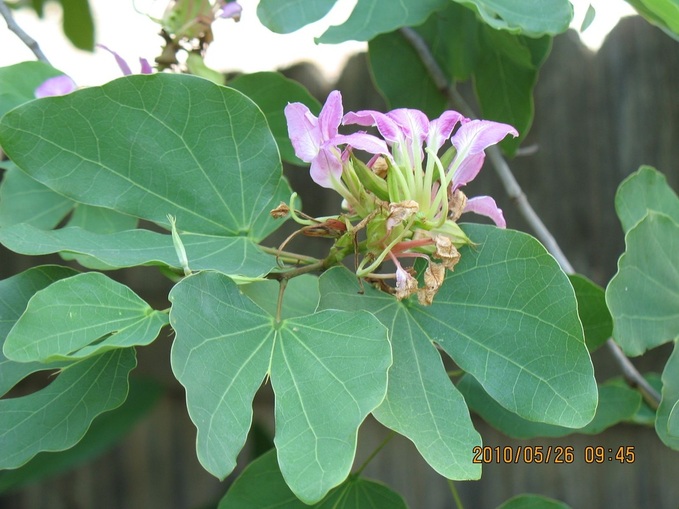 Pink Bauhinia macranthera flower
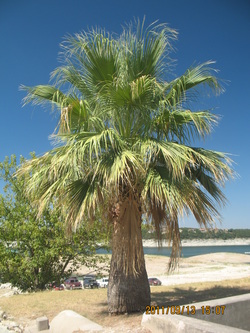 Washingtonia filifera at Lake Travis This past winter taught all of us palm growers in central Texas a lesson. The Mexican fan palm (Washingtonia robusta) is cold hardy reliably only to the upper teens Fahrenheit. We experienced 15ºF in many part of town, with some areas even colder. The result was many 20 to 30 foot "totem poles" all over the area. Lifeless specimens of W. robusta adorned the landscape in many a yard. I've got one myself. I guess all of us palm growers always knew this to be a possibility, but with a long stream of warm winters starting way back in the 1990's, we began to think this was zone 9. Until the past two winters, my average lowest low at my house was 21ºF, which is a zone 9 temperature. The past two winters changed all that with lows between 12ºF and 15ºF. This is where you begin to think of alternatives...
There is a tougher, more cold hardy relative of good old W. robusta, known as the California Fan Palm, California Cotton Palm or Desert Fan Palm (Washingtonia filifera). This palm is native to the southwest deserts in parts of southeast CA, southwest AZ and a bit of Sonora, Mexico. This palm has grayish-green leaves and relatively fat trunk. It grows a bit slower than W. robusta, but is tough as nails. This palm will tolerate the punishment of days on end of single digit temperatures. This happened in 1983 and 1989 in TX, and most all the W. filifera palms survived both those freezes. The Mexican Fan Palms (W. robusta) were all fried and ready for the chainsaw. There are big specimens of W. filifera all over the southern half of Texas, easily seen on the streets of Galveston, San Antonio and Austin. There are even a few of these doing well in Dallas. After this year's freezes, I noticed all the still-green W. filifera trees all over Austin and surrounding communities this spring, and wondering why I didn't plant one of those instead. I guess it could be that the big box stores usually only carry the W. robusta for sale. I have since collected seeds for W. filifera, and I've got several of these little guys growing in pots ready to be planted out.
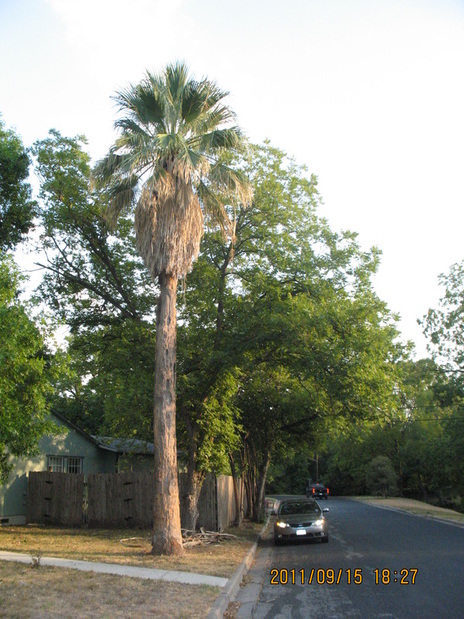 Full-sized adult Washingtonia filifera in Austin, TX
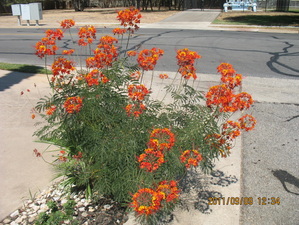 Pride of Barbados on a street corner It's that time of year again. Reddish-orange flowers everywhere around town here in Austin, TX. I'm talking about the Pride-of-Barbados (Caesalpinia pulcherrima). This plant is a prolific bloomer from about July til frost in November or December. It can attain a height of 8 feet or more here, but usually is about 5 to 6 feet. This plant is root hardy here in zone 8, freezing back to the ground and returning to bloom by summer. It is easy to grow from seeds as long as you scratch the seed coat and swell them before planting. It is tough and very drought and heat tolerant. Ours here have taken over 80 days of 100ºF this year and are still going strong, producing tons of flowers and seeds.
An interesting fact about this plant is that there are two distinct forms in cultivation. One is the form grown in the Caribbean and Florida, which has rose-like thorns on it and gets almost tree-like. This is likely the real "Pride-of-Barbados", as it does grow there. The second form is a smaller form with bluish green leaves but with identical flowers. This is the Sonoran form, which is found in Southwest Mexico, and is a big time bloomer during the summer monsoon season there. This wonderful form has no real thorns, only small soft harmless bristles along the stems. This is the one commonly grown in central Texas. As a bonus, it's a little more cold hardy than the Caribbean form. Cheers to the P-O-B!!
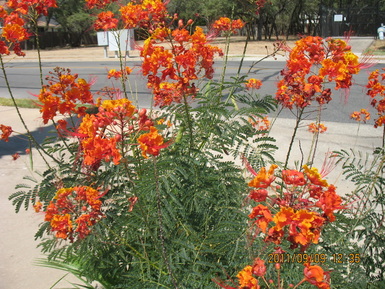 Caesalpinia pulcherrima - Sonoran form
 Sabal minor and a sunset Cold hardy subtropical plants can really lend a cool, laid back feel to any landscape located in a warm enough zone (7 and warmer, and sometimes a 6 with extra protection). Many palms are tough enough to tolerate quite a beating from old man winter as long as the roots are protected. Sabal minor is a wonderful addition to a yard under trees or in the open, and is super hardy. These guys are native to most of the southeastern U.S., and grow as far north as zone 7 in areas like SE Oklahoma and southern Arkansas. This small palm has little to no trunk and has cooling blue-green leaves. It is easy to grow, but like most Sabals, grows slowly. It can be found fairly easily in the nursery trade in southern states, or for some real fun, grow your own from seed using baggies and sphagnum moss. A mature Sabal minor will tolerate down to at least 0°F. The leaves will be frozen off, but as long as the ground doesn't freeze solid, it will resprout once the weather warms. One form of this palm that is particularly friendly to use in a small yard is the super dwarf form from near Blountstown, FL. This really small version of Sabal minor will fit almost anywhere because it only gets maybe 18 inches tall (to the tops of the leaves). This lilliputian form is super cold and drought hardy, having taken ice, snow and horrible drought conditions. With all this, it still produces tons of seed. One of the best ever!
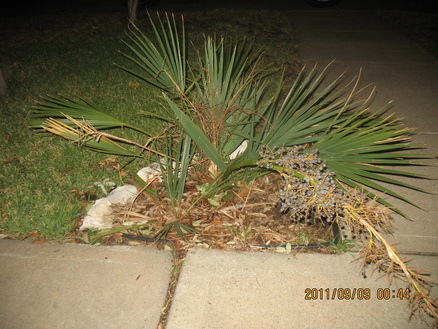 Sabal minor - Blountstown dwarf about 15 years old
|








 RSS Feed
RSS Feed
